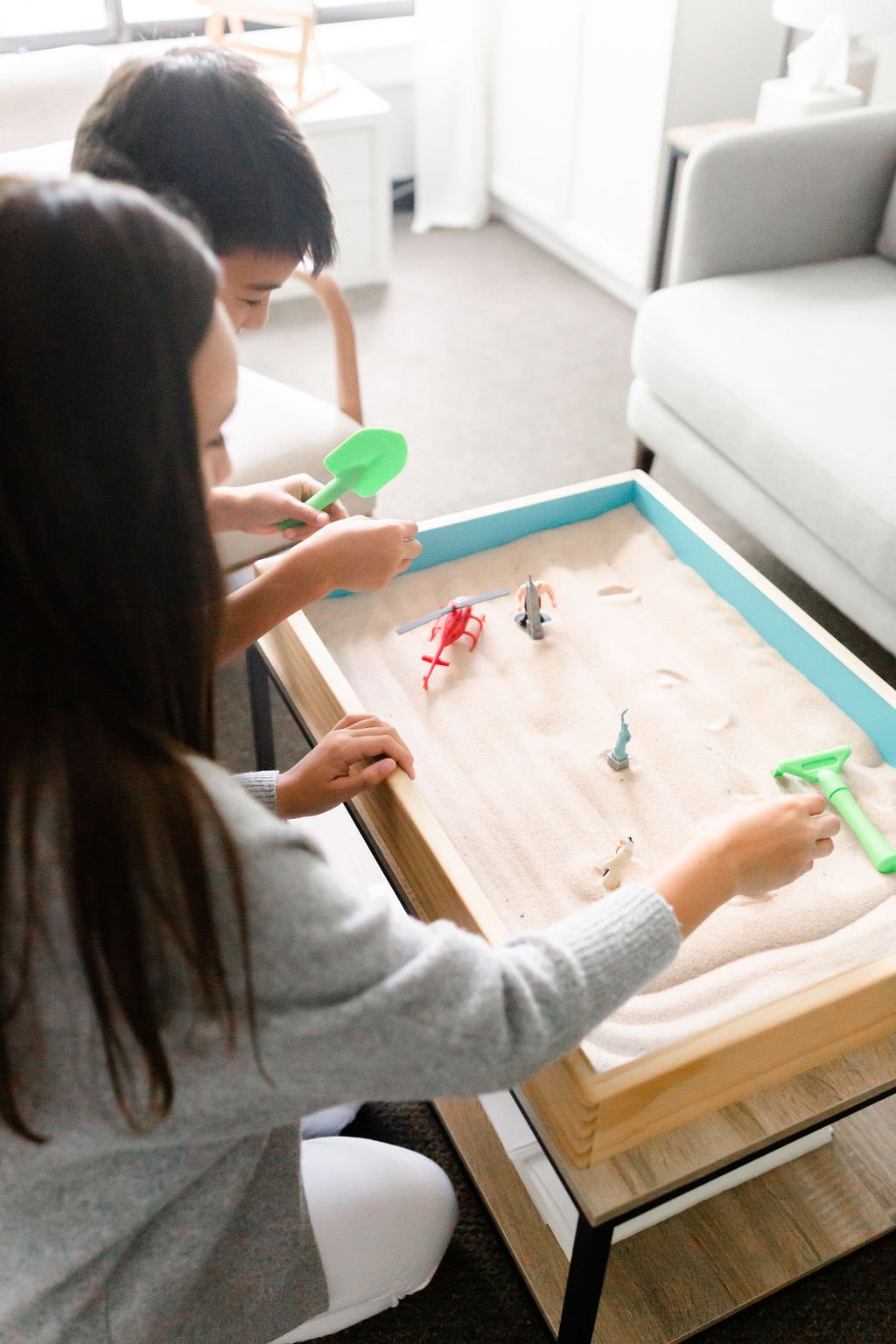Sand Tray Therapy
Sand tray is a unique form of therapy that makes use of symbols, imagination, and the creation process. The physical quality of the sand can be comforting and healing, while the use of the miniature figures can be reminiscent of play. While it may seem childish to use sand and miniatures to share experiences and express feelings, it is a powerful therapeutic tool that is commonly used with adults. Similar to art therapy, sand tray therapy can help adults express thoughts and feelings when words alone are not enough. The ability to create a world in the sand and gain distance from it physically and metaphorically allows us to also gain perspective, safety, and the ability to reflect. Many clients are surprised by the objects and figures they choose to place in their sand tray and often discover things about their lives and relationships they had not been able to articulate but needed to express.
At Sage House Therapy & Art Therapy Counseling, we offer sand tray therapy for all clients, but understanding it may be a new experience for many. We listen carefully to you and tailor our approach to your comfort level. You may find you enjoy using the sand tray and it is helpful in moving your therapy forward. You may wish to use it occasionally when feeling “stuck” or you can decide it isn’t for you. All of these variations are completely acceptable and there is no one “right” way to approach our work together.
How Does Sand Tray Therapy Work?
Our office offers a certified sand tray, which is built to specific proportions, features a natural, sanitized sand tray and a blue interior, which represents water. Our office has a large collection of miniatures that include: human figures, animals, objects from nature, vehicles, fantasy, and other important symbolic objects for use in therapy. The purpose of the miniatures is to represent all the elements of life: what is beautiful and ugly, good and bad, comforting and frightening, happy and sad. The sand tray therapist is trained in providing an accepting and safe environment that allows each client to explore and create a world to reflect an inner feeling, current or past experience, memory, or traumatic event. Some clients ask if they need to be creative to work in the sand tray. There is no requirement to make the sand tray creative and your therapist will help to guide you through the process. There is also no right or wrong way to create a world in the sand and each person’s creation will look different. Some people like to use only the sand while others will make use of the blue “water” symbolized at the bottom of the tray. Many will include some miniature objects to create their worlds. The therapy happens both during the creation as well as after. Depending on what feels most helpful, you and your therapist will explore the world that has been created and the story that goes with it. It is during this time that profound connections and healing can occur.
We know from recent research studies that some of the most significant traumatic experiences in our lives are stored in the visual parts of our brains. We create images in our minds of an experience before we put words to this experience. In trauma, the visual experience is stored as a flashbulb or fragments often with painful emotions that we struggle to put into words. This is where the sand tray process can activate the nonverbal, allowing you to access emotions as well as find new solutions and healing through the creation and sharing process. It is through this process that clients often report increased self-expression, self-awareness, and a greater depth of communication and self-compassion.
Sand Tray Therapy for Adults
We know that sand tray is particularly helpful for adults who struggle with perfectionism, a history of trauma or loss, family or relationship issues, and those who just feel “stuck” in life, work, relationships and/or patterns of thinking or behaving. If you struggle with any of the issues sand tray therapy might be particularly helpful to incorporate into your treatment plan. Your therapist will make recommendations based on your therapy goals to create a customized plan for you. Want to learn more about how sand tray therapy helps address your specific concerns?
Visit our blog post to learn more by clicking here.
Sand Tray Therapy for Children
Sand tray can be a very effective therapy tool for healing, especially for children who are often developmentally too young to put words to complex feelings and thoughts. The sand tray offers a language of symbols through storytelling which comes naturally to children.
The sand tray engages the child’s imagination and allows for a collaborative creation process in which the therapist is “allowed into” the world of the child. For children who use the language of symbols, art, and play to process experiences and make sense of their feelings, the sand tray is a natural tool for expression. Children quickly take to the feel of the sand on their hands and the tiny world of miniatures that give life to their deepest wishes, fears, and the narrative of their internal world.
Similar to art therapy, sand tray therapy can help children express to adults their thoughts and feelings when words are not as readily available. By empowering a child to create a world and then gain mastery over that world, we provide not only an outlet for expression but also a vehicle for growth and reflection under an umbrella of safety.
At Sage House Therapy & Art Therapy Counseling, we offer sand tray therapy for all children. While a new experience for some kids, many find it comforting and similar to what they have experienced in play before either at home or at school. As therapists, we listen carefully to your child as well as you, the parent, to tailor our therapy approach. We often find the sand tray aids in providing parents with a better understanding of their child’s inner world and when appropriate may invite parents to participate in a session in which the sand tray is used. For some children and families, we may only use the sand tray when the child is feeling “stuck”. Our priority is to allow the child and the parent to gain the most insight and means of expression in order to move the therapy process forward.
Is Sand Tray Therapy Right for My Child?
We know that sand tray is particularly helpful for children who are non-verbal, have selective mutism, lack a robust emotional vocabulary, are emotionally disengaged or those who “shut down”. Children who have experienced abuse, loss, or relationship conflicts are ideal candidates for sand tray therapy. Sand tray therapy is also particularly effective with children who tend to suppress emotions and intellectualize concerns. Children who act as a parent to their own parent or sibling as well as children who struggle with perfectionism also benefit from this approach. Your child’s therapist will speak with you in-depth and make recommendations based on your family’s therapy goals to create a customized plan for your child.




